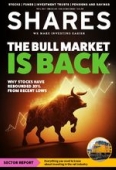Archived article
Please note that tax, investment, pension and ISA rules can change and the information and any views contained in this article may now be inaccurate.
Cash savings account: should I go for a fixed or variable rate?

When it comes to cash savings accounts, the variety of options available can make your head spin if you’re not careful.
A fixed-rate account promises you a specific return on your savings over a defined period. This can range from a single year, up to five, sometimes even more.
Your interest rate is constant, it does not matter whether the Bank of England’s base rate rises, falls, or does a jig, your return stays the same.
There is an appealing certainty here. You know exactly what you will get, when you will get it, and you can plan accordingly. It also serves as a rather effective diet plan for your spending urges, because if you withdraw your money early, you will usually face a penalty.
In contrast, a floating or variable-rate savings account does not offer the comfort of predictability, with the interest rates bobbing up and down, typically tethered to the Bank of England base rate.
KEY ADVANTAGES
A key advantage is flexibility. Variable rate accounts generally allow you to dip into your savings whenever you want without any penalties.
The rates on offer from both types of account are a key consideration too, though it is difficult to predict over any time period whether fixed or variable rates will turn out better, because the latter are determined by what the Bank of England’s interest rate setting committee decides at each of its meetings.
At the moment the best one-year fixed account is offering 5%, while the best variable easy access account is offering just under 4%, according to Moneyfacts.
However, with interest rates expected to rise over the rest of this year, the variable account should provide higher rates too in time.
WHERE MIGHT BASE RATES END 2023?
Currently the market is pricing in that base rate will rise to 5.75% by the end of the year, but these expectations can change at the drop of a hat.
Ultimately, they may not be borne out in reality either, that is entirely down to the Bank of England. In the meantime, with each month that passes with variable rates below fixed rates, the variable rate account also has to make up for the lost interest relative to the fixed rate account before breaking even.
However, if interest rates really take off, the return on the fixed-rate account could start to look shabby by comparison, and that is a bigger risk when fixing for longer periods because you would not be able to change account for a long time to take advantage of higher market rates.
TAX ISSUES TO CONSIDER
You should also be mindful of the tax situation. Variable accounts pay interest regularly throughout the year, whereas fixed-rate accounts will tend to pay once a year on the anniversary of you opening the account, and this determines the tax year in which the interest is taxable.
There may therefore be some value in choosing one rather than the other depending on your tax situation. For instance, if you are about to retire in six months’ time and drop down a tax band from 40% higher rate to 20% basic rate, a one-year bond will push your interest into the next tax year when you’re a basic-rate taxpayer.
Both fixed and variable-rate accounts are also available within a cash ISA, where all the interest is tax-free. However, remember to compare the rates.
Some non-ISA accounts offer higher interest rates that might outweigh the tax benefits of a cash ISA. And if you’re a basic-rate taxpayer with savings interest under £1,000, you already have a personal savings allowance that shields your interest from tax. For higher-rate taxpayers this allowance is only £500 and for additional-rate taxpayers it is zero.
More people are likely to be breaching this allowance now that interest rates have risen so sharply, so a cash ISA might come in handy. The Treasury can always cut or do away with the personal savings allowance too, so putting money into an ISA protects you from further government meddling on that front.
The wide range of cash accounts does take a bit of effort to get your head around, but at least it does mean that you have lots of options which can be tailored to your individual needs.
If you have a variety of savings goals, like most people, you can split your cash up between variable and fixed-term accounts to hedge your bets a little, locking into some higher returns, but also maintaining some flexibility.
Important information:
These articles are provided by Shares magazine which is published by AJ Bell Media, a part of AJ Bell. Shares is not written by AJ Bell.
Shares is provided for your general information and use and is not a personal recommendation to invest. It is not intended to be relied upon by you in making or not making any investment decisions. The investments referred to in these articles will not be suitable for all investors. If in doubt please seek appropriate independent financial advice.
Investors acting on the information in these articles do so at their own risk and AJ Bell Media and its staff do not accept liability for losses suffered by investors as a result of their investment decisions.
Issue contents
Feature
Great Ideas
News
- Why Vodafone’s marriage of convenience with Three leaves questions hanging
- Cost of UK mortgages breaches 6% while June house prices fall for the first time in five years
- Shares in this US restaurant business more than doubled on its stock market debut
- Motorpoint shares slump as profit wiped out amid a multitude of factors
- Unfavourable exchange rates leave many Japan fund investors lagging Japanese stock rally

 magazine
magazine








